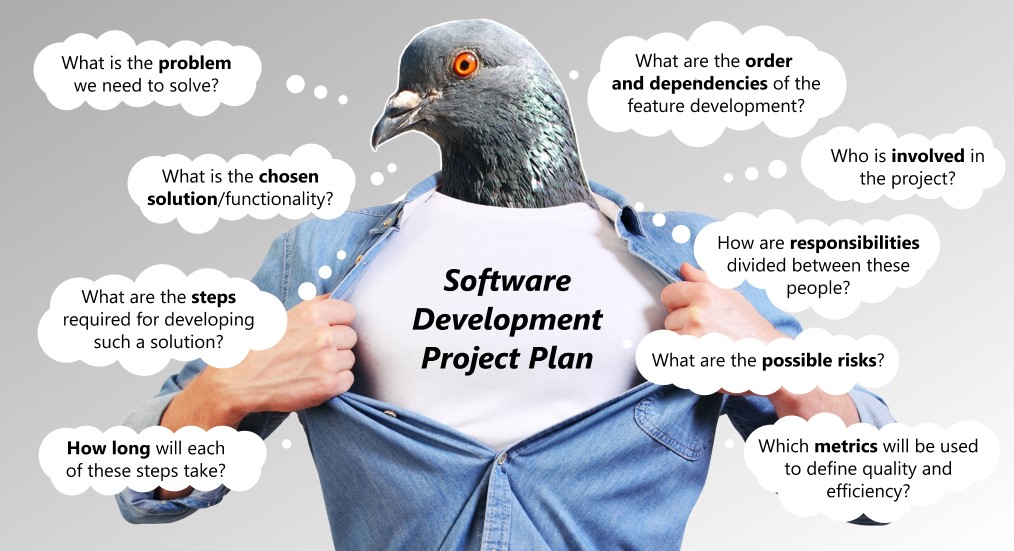Once there is a great idea on the table, there is also a temptation to jump right into its execution, especially in the case of startups. However, just like a house cannot be built without a blueprint, a software development project cannot be executed without a plan. Adequate project planning can not only save the idea from failure but also help a company to use its resources wisely. In this post, we would like to discuss the important stages of the software development project plan, following which can help your next project succeed.
written by:
Aliaksandra Tsikhanovich
Once there is a great idea on the table, there is also a temptation to jump right into its execution, especially in the case of startups. However, just like a house cannot be built without a blueprint, a software development project cannot be executed without a plan. Adequate project planning can not only save the idea from failure but also help a company to use its resources wisely. In this post, we would like to discuss the important stages of the software development project plan, following which can help your next project succeed.
Contents
From A to B
From the moment of idea validation to the point of having a finished product delivered to the customers, there is a whole chain of events and aspects that define how successful the path from point A to point B is:
But what are they?
They surely include the scope, budget, and timeline of the project. These are also the most suitable solutions to reach the project goals and the possible changes that might become necessary in the process. And last but not least — the people who turn an idea into reality having their roles being assigned clearly.
Diving right into the software development process without first thinking all of these aspects through can lead to major drawbacks, remakes, wasted time and money, and poor results. While for some bigger companies it means low-quality business practices and unnecessary losses, for startups it can even mean bankruptcy and a missed opportunity.
On the other hand, creating a solid software development project plan allows optimizing the process by describing it step-by-step and predicting all feasible pitfalls, as well as guaranteeing deliverables. Let’s have a deeper look into what such a plan has to offer to any business and how to create one.
What Is a Software Development Project Plan and Why Is It Necessary?
While the project manager is a person overseeing and supervising the entire development process, the software development plan is his or her main tool for performing the job successfully, as well as creating an alignment among all the involved parties. It is a reference document that determines the critical aspects of a project from start to finish: the approach, the goals, the approved methods of execution and monitoring, time and budget, identified hidden costs, etc. It helps to plan the software development process better, prevent miscommunication, stay on target, and guide the team when it hits a dead end.
Furthermore, project planning gives space for discussing and discovering solutions that work best for a particular case by taking into account everyone’s expertise, instead of just going with the first proposed approach that might fail later.
To sum up, the software development project plan has to provide clear answers to the following questions.
Software Development Plan. Example Structure
No matter the exact type of software to be developed, the key components of planning and execution are usually the same and it is the first step to identify those components. This is why we would like to examine the structure of a software development project plan, which typically includes five following sections.
1. Introduction
Before anything else can be done, it is important to first define the project and create a clear understanding of its purpose, concept, and goals for everyone. After interviewing the stakeholders, researching the potential users, and collecting as much information as possible, these are the important aspects that need to be described during this stage:
Project Description & Definition
Defining the project starts with a thorough description of what this project is aiming to do and how. Besides, it is also necessary to include the reasoning behind the decision to work on this specific project. There is usually more than one way to solve the raised issue and it is essential to prove why the picked solution is the most suitable. Then, there should also follow a description of who is the target audience and how they are going to be approached, as well as how the solution is going to be monetized.
Project Requirements
With the explicit vision of the product, it is now possible to identify business requirements and, then, translate them into technical ones. The close collaboration between business and technical teams is vital for getting this part right.
Project Goals & Scope
Now, the goal is to paint a clear picture of what is planned to be achieved during this project, this step defines the rest of the project. The specific goals and requirements identified above, features, deliverables, deadlines, and costs need to be all documented. It helps to set expectations clearly and avoid fluctuating too much from the target when getting unplanned requests.
2. Project Organization
Another important starting point is identifying the people who are going to bring the project to life. The structure and hierarchy of the teams, their responsibilities, functions, and interactions, as well as any other external participants (non-directly or part-time involved teams, experts, etc.) — all need to be mentioned here.
This section helps to increase transparency and make collaboration between teams more convenient.
3. Project Management
Now that the scope and the teams are all defined, it is time to get into the specifics of the project flow and management. This section is about dividing the workflow and providing more detailed estimates. Thus, the following parts need to be covered.
Project Management Methodologies
There are several established approaches and methodologies that help to make the process more efficient, and it is time to pick one, as it will determine how things will unfold further on. Some of the most common practices are Agile, Scrum, Kanban, Waterfall, Lean, etc. However, according to the research conducted by the Project Management Institute, 89% of the professionals prefer to implement hybrid project management practices to best tackle the outlined tasks.
Project Division
The project goals and requirements have been already identified earlier and now it is time to turn them into achievable tasks. The whole process needs to be broken down into general phases, such as the design phase, implementation phase, testing phase, etc., and then phases can be broken down into specific tasks that can be assigned to the responsible team members. Each accomplished task should have a deadline and result in a deliverable that can be tested and measured.
Order of Operations
It is also necessary to identify the order of the tasks, their duration, and dependencies between each other or, in other words, which tasks need to be accomplished before the next one can be started. One of the most efficient tools for doing this is a Gantt chart, as it provides a visual representation of all tasks in one place, allowing the most efficient scheduling and reducing the timeline.
Estimates
Once the tasks have been divided, it is possible to provide estimates of the workload, predicted duration, costs, and required resources.
Risk Management
No matter how much planning is done, there are always going to be some pitfalls and deviations from the original plan. It is vital to identify potential risks in advance, always necessary to expect that things might go not as expected, and, for this reason, add extra time and budget into the plan for risk management and flexibility. It is always better to under-promise and over-deliver than the other way around. Furthermore, the proper original planning allows keeping things more under control and fix unforeseen issues with minimal downtime.
The project management section of the software development plan needs to be constantly reviewed throughout the project to stay relevant and reflect the likely shifts in the estimates and deliverables. It is also crucial to get the feedback of different teams on this section before moving forward to ensure the most suitable technical choices are in place. It is often necessary to take a few steps back and make adjustments in the plan.
4. Project Control
In order to ensure successful project implementation, it is essential to define the tangible metrics beforehand and continuously monitor the quality and efficiency of the workflow and the delivered results. Some of the facets that can help with better quality control are:
- tools that are used to control whether the product corresponds to the established requirements;
- tracking of the time and budget spent;
- real-time access to the code quality control reports;
- clear definition of what considered to be an accomplished project;
- timely updates of the management team and stakeholders on the progress and methodology;
- timely updates and well-established communication on the changes performed in the project, etc.
5. Maintenance & Support
Once the software development process has been finalized, there is still the ongoing need for technical assistance to keep the product up-to-date and running without any issues. For this reason, a detailed plan on documentation, maintenance, and support processes should be recorded as part of the project plan too. It should include a list of the types of assistance that the development team will provide to the product owners, some of which can be: continuous testing and maintenance, fixing of the technical issues, upgrade planning, etc. This section of the software development project plan ensures the scalability and sustainability of the created product.
Final Thoughts
Any software development project plan takes time, however, it is a worthwhile investment, as it might be exactly what stands between your project’s failure and success. It sets a foundation and provides a clear direction for the whole development process while also ensuring its efficiency.
However, as mentioned earlier, there are always things that can go wrong and some of the risks are associated directly with the planning process. Hence, it is important to keep them in mind to be able to avoid them:
- tackling the incorrect needs — it is necessary to review the project plan continuously to make sure it still addresses the valid needs, as the understanding of the project is expanding. It is also important to not disregard the user validation stage, as it can lead to developing an irrelevant solution;
- teams are not aligned — as it was mentioned earlier, the alignment of all teams is essential for the successful project implementation. It is crucial to establish timely and systematic communication between teams early on;
- the first estimates are highly approximate — it is necessary to make it clear to the stakeholders that time and budget estimates are only approximate and can vary depending on various factors and risks;
- the size of the project influences success rates — the bigger the scope of the project is, the higher are chances of unexpected bottlenecks in the process, which may cause delays in the timeline.


Contacts
Feel free to get in touch with us! Use this contact form for an ASAP response.
Call us at +44 151 528 8015
E-mail us at request@qulix.com












